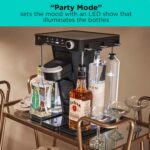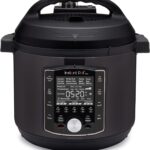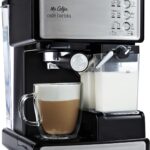So you’ve probably had your fair share of coffee, maybe even tried espresso before. But have you ever wondered if espresso is just finely ground coffee? Well, today we’re going to unravel the mystery and get to the bottom of this caffeinated conundrum. So grab a cup of joe and let’s explore the world of espresso and its relationship to finely ground coffee.
What is Espresso?
Definition of espresso
Espresso is a concentrated form of coffee that is made by extracting flavor from finely ground coffee beans. It is characterized by its strong flavor, thick crema layer, and shorter brewing time compared to regular coffee. The term “espresso” comes from the Italian word meaning “pressed out,” which refers to the method of brewing where hot water is forced through the coffee grounds under high pressure.
How espresso is made
To make espresso, you start with high-quality coffee beans. These beans go through a series of processes, including harvesting, drying, and roasting, to bring out their unique flavors. Once the beans are ready, they are finely ground to a consistency similar to table salt. The ground coffee is then packed into a metal or plastic filter, known as a portafilter.
Next, the portafilter is inserted into an espresso machine. Hot water, heated to around 195-205°F (90-96°C), is forced through the packed coffee grounds under pressure. This results in a highly concentrated liquid, known as espresso, being extracted into a small cup in just a matter of seconds. The entire process requires precision and skill to ensure the perfect balance of flavors and consistency in each shot.
The Coffee Bean
Types of coffee beans
There are two main types of coffee beans used to make espresso: Arabica and Robusta. Arabica beans are known for their mild and nuanced flavors, often exhibiting floral or fruity notes. They have less caffeine content compared to Robusta beans and are considered higher in quality.
On the other hand, Robusta beans are more robust and have a higher caffeine content. They are often used in espresso blends to provide extra body and a stronger taste. Robusta beans are also known for their earthy and bitter flavors.
Growing regions
Coffee beans are grown in various regions around the world, each with its unique climate, altitude, and soil conditions. Some of the renowned coffee-growing regions include South America (Brazil, Colombia), Central America (Costa Rica, Guatemala), Africa (Ethiopia, Kenya), and Asia (Indonesia, Vietnam). These regions contribute to the flavor profiles of the coffee beans, as factors like altitude and soil composition influence how the beans develop their flavors and aromas.
Roasting process
After the coffee beans are harvested and dried, they undergo the roasting process. Roasting is a crucial step that transforms the beans into the familiar brown and aromatic coffee we know. The duration and temperature of the roast greatly affect the final flavors and characteristics of the beans.
Espresso beans are typically roasted to a darker roast level to accentuate their bolder and richer flavors. However, preferences for roasting levels may vary, with some espresso blends opting for a medium or lighter roast to highlight the bean’s unique qualities.
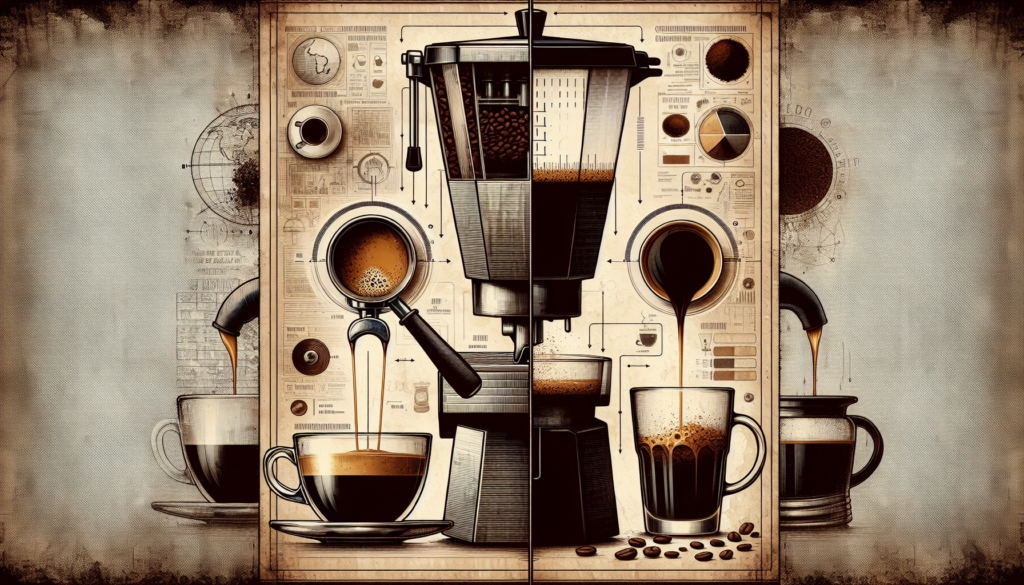
The Grinding Process
Importance of grinding
Grinding coffee beans just before brewing is essential for making a quality espresso. The grind size affects the rate at which flavor is extracted during the brewing process. For espresso, the grind needs to be much finer than that used for regular coffee, as this allows for increased surface area and optimal extraction.
Grinding the coffee beans too coarse will result in under-extraction, which leads to a weak and watery shot. On the other hand, grinding too fine can cause over-extraction, resulting in a bitter and unpleasant taste. Achieving the right grind size is crucial for obtaining a balanced and flavorful espresso shot.
Different types of grinders
There are various types of grinders available for home and commercial use. Blade grinders, which use spinning blades to chop the coffee beans, are the most basic and affordable option. However, they may produce inconsistent grind sizes, leading to uneven extraction.
Burr grinders, on the other hand, offer a more precise and consistent grind. They use two abrasive surfaces (burrs) to crush the coffee beans to a uniform size. Burr grinders can be further divided into two categories: flat burr and conical burr grinders. Conical burr grinders are often preferred for espresso due to their ability to produce a finer and more consistent grind.
Grind size for espresso
The grind size for espresso is much finer than what is typically used for other brewing methods. It should resemble the texture of finely ground table salt. This fine grind allows for the water to pass through the coffee grounds at the correct rate, extracting the flavors and aromas effectively in a short amount of time.
Achieving the right grind size requires experimentation and adjustments, as factors like the roast level, humidity, and the specific espresso machine being used can influence the optimal grind size. The goal is to achieve a extraction time of approximately 25-30 seconds, resulting in a balanced and well-rounded espresso shot.
Understanding Extraction
The role of extraction in coffee brewing
Extraction is the process of dissolving and extracting the soluble compounds, flavors, and aromas from the coffee grounds using hot water. It is a crucial step in coffee brewing, as it directly impacts the taste and quality of the final cup.
In espresso brewing, extraction occurs rapidly due to the high pressure and short brewing time. The hot water is forced through the finely ground coffee, extracting the desirable compounds and leaving behind the undesirable ones. The result is a concentrated shot of espresso with a unique flavor profile.
Factors affecting extraction
Several factors can affect the extraction of flavors during the espresso brewing process. The grind size, water temperature, pressure, and even the tamping technique all play a role in the extraction process.
If the grind size is too coarse or the water temperature is too low, under-extraction occurs, resulting in a weak and sour shot. Conversely, if the grind size is too fine or the water temperature is too high, over-extraction can lead to a bitter and astringent taste.
The amount of pressure applied during extraction is another critical factor. The ideal pressure range for making espresso is typically between 8 and 9 bars. This pressure helps to create the necessary resistance for water flow, ensuring a balanced extraction.
Optimal extraction for espresso
The optimal extraction for espresso is a balance between acidity, sweetness, and bitterness. It results in a shot with a rich and full-bodied flavor, a well-defined crema, and a pleasant aftertaste.
To achieve optimal extraction, various variables need to be carefully controlled. These include using freshly roasted and properly stored coffee beans, ensuring the correct grind size, maintaining the proper water temperature and pressure, and practicing consistent tamping techniques. It may require some trial and error to find the perfect combination, but once achieved, the results are worth the effort.
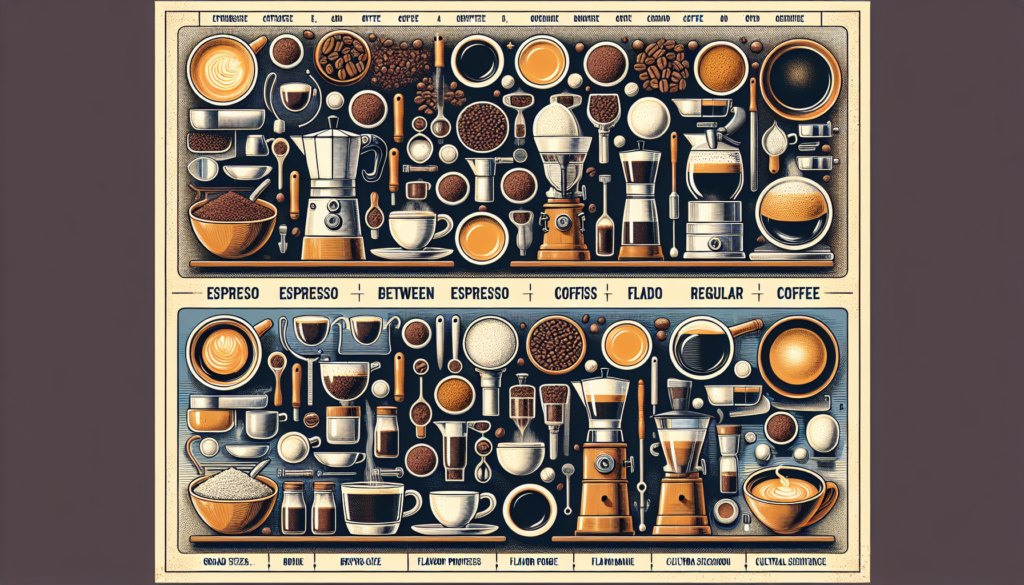
Espresso Preparation
Espresso machines
Espresso machines are specially designed to create the high pressure necessary for making espresso. There are two main types of espresso machines: manual (lever-operated) and automatic (pump-driven).
Manual espresso machines require the user to manually apply pressure by pulling a lever to force the hot water through the coffee grounds. They offer greater control over the extraction process but require more skill and practice to master.
Automatic espresso machines, on the other hand, use an electric pump to generate the necessary pressure. They are easier to use and more popular in commercial settings due to their consistency and efficiency.
Espresso shot timing
Timing is crucial when making espresso. The duration of the extraction, known as the shot timing, greatly affects the flavor and quality of the espresso shot. The ideal shot timing for a single shot of espresso is typically around 25-30 seconds.
If the shot extraction takes too long, it may result in over-extraction and a bitter taste. Conversely, if the shot extraction is too short, it may result in under-extraction and a weak flavor. Monitoring the shot timing ensures that the espresso shot is extracted within the desired time frame, bringing out the best flavors from the coffee grounds.
Water temperature and pressure
Water temperature and pressure are key factors in making a good espresso shot. The water temperature used for brewing espresso should be between 195-205°F (90-96°C). This ensures optimal extraction of flavors from the coffee grounds without scorching them.
The pressure applied during extraction should be within the range of 8 to 9 bars. This level of pressure provides the right balance for extracting the flavors and oils from the coffee grounds while also maintaining the desired crema layer on top of the espresso.
Tamping technique
Tamping is the process of evenly distributing and compacting the coffee grounds in the portafilter before extraction. It ensures a consistent and even flow of water through the coffee bed, allowing for a more even extraction.
A proper tamping technique involves applying firm and even pressure to the coffee grounds using a tamper. The tamper should fit snugly within the portafilter and be leveled to ensure an even surface. This helps to prevent channeling, where water finds paths of least resistance through the coffee bed, resulting in an uneven extraction.
Flavor and Aroma
Differences in flavor between espresso and coffee
Espresso and regular coffee differ in flavor due to variations in the brewing methods and the concentration of coffee used. Espresso is known for its strong and concentrated flavor, with a full-bodied and robust taste. It often exhibits bittersweet notes and a velvety mouthfeel.
On the other hand, regular coffee, brewed using methods like drip brewing or French press, tends to have a milder and more diluted flavor. It allows for a wider range of nuances and aromatics to come through, giving the coffee a lighter and more delicate taste.
Aroma profiles
The aroma of espresso is an integral part of the overall coffee experience. It is influenced by factors such as the bean origin, roast level, and the extraction process. Espresso often exhibits a strong and complex aroma, with hints of chocolate, caramel, nuts, and fruit.
The aroma profile of espresso can vary greatly depending on the specific bean, roast, and brewing parameters. Some espresso blends may have more floral or fruity notes, while others may have more earthy or spicy undertones. The aroma adds depth and complexity to the overall flavor experience.
Acidity and bitterness
Acidity and bitterness are two important factors that contribute to the flavor profile of espresso. Acidity refers to the brightness or sharpness of the flavor, while bitterness refers to the more intense and sometimes harsh taste.
Espresso generally has a lower acidity compared to regular coffee. The high-pressure brewing process of espresso tends to extract fewer acidic compounds, resulting in a smoother and less acidic flavor profile. However, certain espresso blends or single-origin beans may still exhibit noticeable acidity.
Bitterness can be more pronounced in espresso due to the higher concentration of coffee used in the brewing process. Bitterness can sometimes be a desirable characteristic, adding complexity to the overall flavor profile. However, excessive bitterness can indicate issues with the brewing process or the quality of the coffee beans.
Caffeine Content
Is there more caffeine in espresso?
Contrary to popular belief, espresso does not necessarily have more caffeine than regular coffee. While espresso is more concentrated, the serving size is much smaller. On average, a 1-ounce (30ml) shot of espresso contains around 63 milligrams of caffeine.
In comparison, an 8-ounce (240ml) cup of brewed coffee typically contains anywhere from 95 to 165 milligrams of caffeine, depending on various factors such as the type of coffee beans, brewing method, and the strength of the brew. Therefore, in terms of caffeine content per serving, regular coffee generally contains more caffeine than a single shot of espresso.
Serving size comparison
The serving size of espresso is significantly smaller than that of regular coffee. A standard espresso shot is typically 1 ounce (30ml) in volume. This small serving size is intended to be consumed quickly and provides a concentrated burst of flavor and caffeine.
On the other hand, a regular cup of coffee can range anywhere from 8 to 16 ounces (240 to 473ml), allowing for a more extended and leisurely drinking experience. The larger serving size of regular coffee provides a more gradual release of caffeine, making it a preferred option for those looking for a milder pick-me-up throughout the day.
Effects on caffeine sensitivity
Individuals may have varying levels of caffeine sensitivity, which can affect how they react to both espresso and regular coffee. Some people may find that the concentrated nature of an espresso shot leads to a more instantaneous and intense caffeine buzz. Others may prefer the slower release of caffeine provided by regular coffee.
It’s important to consider your own sensitivity to caffeine and how it affects your body. Moderation is key, and it’s advisable to monitor your caffeine intake and adjust accordingly to avoid any negative effects on sleep, digestion, or overall wellbeing.
Popular Espresso Drinks
Cappuccino
Cappuccino is a classic espresso-based drink that consists of equal parts espresso, steamed milk, and milk foam. It is typically served in a small cup and is known for its beautiful layers of espresso, milk, and foam. The balance between the espresso and the milk provides a creamy and smooth texture, while the foam adds a touch of elegance to the overall presentation.
Latte
A latte is another popular espresso-based drink that is similar to a cappuccino. It is made by combining a shot of espresso with a generous amount of steamed milk, topped with a small amount of milk foam. Lattes have a higher milk-to-espresso ratio compared to cappuccinos, resulting in a creamier and more mellow flavor. They are often enjoyed with a sprinkle of cocoa or cinnamon on top.
Macchiato
An espresso macchiato is a simple yet flavorful espresso-based drink. It consists of a shot of espresso “stained” or “marked” with a small amount of milk foam or steamed milk. The word “macchiato” in Italian means “stained” or “spotted,” referencing the small amount of milk used. Macchiatos have a bolder and more pronounced espresso flavor compared to other milk-based espresso drinks.
Americano
An Americano is a diluted version of espresso made by adding hot water to a shot of espresso. It is similar to drip brewed coffee but with a more intense and concentrated flavor. Americanos are often enjoyed black, but can also be customized with milk or flavorings. This drink provides a less concentrated and milder option for those who prefer a longer and more traditional coffee experience.
Mocha
A mocha, also known as a mochaccino, is a delightful combination of espresso, steamed milk, chocolate syrup, and whipped cream. It is a popular indulgent drink that appeals to coffee and chocolate lovers alike. The rich and velvety taste of the chocolate blends harmoniously with the boldness of the espresso, creating a decadent and satisfying treat.
Espresso and Health
Potential benefits
Espresso, when consumed in moderation, can offer certain health benefits. The caffeine content in espresso can provide a temporary boost in alertness and focus. It may enhance cognitive function and improve mood. Additionally, coffee, including espresso, contains antioxidants that can help fight against inflammation and reduce the risk of certain diseases, such as Parkinson’s disease and some types of cancer.
Considerations for consumption
While espresso can have potential health benefits, it’s important to be mindful of certain considerations. Caffeine sensitivity varies among individuals, and consuming too much caffeine can lead to side effects such as restlessness, irritability, increased heart rate, and disrupted sleep. It’s recommended to limit caffeine intake, especially in the evening hours.
It’s also important to note that some individuals may experience gastrointestinal discomfort or acid reflux due to the high acidity of espresso. If you have preexisting health conditions like ulcers or a sensitivity to acidic foods, it’s advisable to consult with a healthcare professional before incorporating espresso into your diet.
Conclusion
Espresso is a unique and complex beverage that offers a concentrated burst of flavor and aroma. Made from finely ground coffee beans, it requires precision and attention to detail throughout the entire brewing process. The careful selection of coffee beans, the art of grinding, the proper extraction, and the knowledge of various espresso-based drinks all contribute to the enjoyment of this cherished beverage.
Whether you prefer a classic cappuccino, a velvety latte, or a simple shot of espresso, exploring the world of espresso is an exciting journey. Understanding the factors that influence the taste, exploring different flavor profiles, and appreciating the artistry behind the perfect shot can elevate your coffee experience.
So, the next time you savor a well-prepared espresso, take a moment to appreciate the craftsmanship and the rich aromas that fill your senses. Immerse yourself in the world of espresso and discover the wonders that can be unlocked with every sip.

